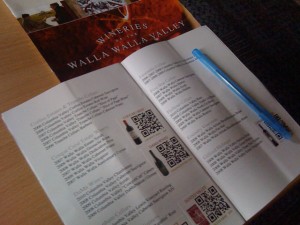
The Program. The Walla Walla Visitor's guide. The pen I didn't use and subsequently forgot to return. Hey, free pen!
The Walla Walla Wine Alliance conducts a tasting in Portland in the spring of every year and it has always been one that I look forward to the most. This is the tasting that highlights this strange land to the East, where the big wines dwell. Here in the Willamette Valley, we have soft wines of finesse; delicate like rose petals, softly falling to the ground on a summer’s breeze. Out there they have strong and burly wines like a road-warrior, spikes and leather peeling out in a cloud of fire and smoke. It’s a bit of a difference and a nice change.
The Walla Walla tasting features about 55 wineries, each serving from three to seven wines. At the entrance to the tasting there was a program listing the wineries present and the wines that were to be served, but it was marginally useful and full of misinformation. Some wineries brought their secondary labels instead of the featured wines. Some brought different wines, either from selling out or a change of heart. Some wineries brought an extra bottle or three. Some winemakers got overly excited and bottled something just in time to show at the tasting. But who wants to taste bottle-shocked wine? That’s another story. (And a movie!)
So here we have about three-hundred wines to choose from. That’s a massive amount of wine. If you’ve done a tasting like this, you know there needs to be a strategy; a plan of attack. Realistically, can you try them all? No. Well, yes. But it’s really tough work. You had better be a pretty seasoned (or marinated, rather) wine taster to pull that off. Would that last wine taste as fresh and clear as the first? Probably not. Quite honestly, attempting to taste them all is just impractical. The palate gets tired, the tasting glass gets sticky and disgusting, and then the crowd makes things a bit more problematic.
Many folks with wine shops, wine bars, restaurants, and so on, have their own mission to find selections for their respective venues. On the other hand, there’s the contingent who attend these things with the sole purpose of socializing and drinking wine for free. Okay, we’re all here to drink for free, but some of us have work to do, too. Since I am now on the writing end of the spectrum, and I no longer have to shop for others, what’s my main mission in this gigantic sea of wine? How do I maximize my time here?
Well, when I tour the wine country in Walla Walla, I tend to pick a theme and stick with it, for maximum impact and adventure. For example, one year I sought out all the best Syrah the town had to offer. This was before everybody had a Syrah, and it was harder to find. More recently, I was determined to hit as many places as possible in a day, and I set the goal of finding all the Cabernet Franc in town. I only visited the places that produced Cabernet Franc. And at those places I would limit my tasting to only the Cabernet Franc, of course reserving the right to sample any of the other pleasant diversions I find on the way. A Marsanne/Roussanne? Mais, oui!
The Walla Walla tasting in Portland is no different. Same wineries, same wines. For the most part. If you know anything about the wine industry in Walla Walla, yo know that everybody has a Cabernet Sauvignon. Everybody has a Merlot. And everybody has a Cab/Merlot blend(s) of some sort(s). I know all those Bordeaux varietals have their noble merit, but after time it bores me unless I have a steak in front of me. With this in mind I set out to find at this tasting anything I would consider “oddball” wines, one of my favorite categories. There is plenty of experimentation in Walla Walla these days, and that’s the kind of thing I appreciate and encourage. Sure, I tried some Cabs, Merlots, Chardonnay, and Syrah. They were all fine and good, but nothing worth noting. Here are a few wines that really stood out from the pack and shouted “Look at me!”
Castillo de Feliciana Winery Tempranillo
These guys are fairly new to me and one of the newer wineries I see popping up all over the South side of town. I love I good Tempranillo, but have found very few in the States that hold a candle to their Spanish ancestors. I’d be proud to say that this one actually does compare to a more European style. I’d love to try this side-by-side with a Ribera del Duero. Nice work, I say. I tried the Malbec too, which was good but might not have made the mention were it not for the Tempranillo.
Beresan Winery Carménère
There are very few single-varietal Carménère made in the US, much less in Walla Walla. This one wasn’t just rare and “oddball”, it was fantastic. It wasn’t overblown and juicy like a Cab, but had the spicy notes I always associate with a good Carménère, especially the classic Chilean ones. I’ve been a fan of a the wine these folks produce, and they pay their homage to experimentation, and do it well.
Buty Winery and Cadaretta Wines Semillon/Sauvignon Blanc Blends
I put these two together because, thanks to the alphabet, these wineries were placed next to each other on the same table. I guess it’s kind of like grade school. You had better learn to like the kids on either alphabetical side of you, because that’s who you’re sitting next to for the next four grades. So I hope the folks at these wineries get along, since they’ll be seeing each other at all the other tastings. Anyway, since they both had the same varietal blend, It only made sense to try them together. The Buty came across with the richer Semillon qualities but seemed to lack the crisp acidity it needed. The Cadaretta was just the opposite, featuring more classic Sauvignon Blanc characteristics, European styling, and a more acidic structure. Y’know . . . I should have blended these two together. That might have been perfect! And I’d have made two enemies at once.
Tranche Cellars “Slice of Pape Blanc” & Barbera
Here I found two gems. The first was the “Slice of Pape” Rhone Style white made with the varietals Rousanne and Viognier. The blended Rhone whites are pleasing on so many levels and, in my opinion, should supplant the straight-up Viognier trend of the past decade. This one was juicy and crisp, leaving me wanting more. There was also a “Slice of Pape” red that was good, but left my socks firmly wrapped around my feet in a non-knocked-off state. The Tranche Barbera at least made my socks fall down to my ankles a little. The Barberas in Washington, in general, just don’t speak Italian. But this one can at least speak with an Italian accent.
Dusted Valley Petite Sirah
Really? A Petite Sirah in Washington? When did this happen? Well, it’s happening now. And this thing was fantastic. Who would have heard of such a thing? I’ve had a lot of Petite Sirah in my time, almost all from that land to the South, but none compare to the elegance of this one, yet with a touch of subtlety. I never expected this. A Petite Sirah in Washington that is this good? “Oh, shit!” says California.
And now for a quadrifecta (or superfecta) of Petit Verdot! I did not expect to see so many of this varietal standing on its own, and I was not disappointed in any of them. This grape, usually relegated to a supporting role here proves that like a shark, it has teeth! Unlike a shark, it also shows that it has legs. Unless, of course it’s a shark that has just eaten a surfer. Then it has legs and teeth and the poetic comparison still stands. On its legs.
Gifford Hirlinger Petit Verdot
The first of four Petit Verdot of the “oddballs and rarities” at the tasting. Gifford Hirlinger winery was another new one to me, also from the South side of town. The Petit Verdot was gripping, with a sturdy backbone and quite a drying quality. I could see some aging potential in this one. Potentially the most complicated of the four. There was also a pleasing Malbec and Tempranillo from these guys.
Saviah Cellars Petit Verdot
I’ve been to this winery a few times and enjoyed their wines a great deal, especially their Syrahs. This, here, was a simpler Petit Verdot, with some toasty oak to it. It was almost too much, but a bit more time and perhaps some food to accompany it would mellow things out. Just like people.
Seven Hills Petit Verdot
I’ve been to the Seven Hills Winery and tasting room often. They’ve been around for quite a while, and they’re easy to find in town. They also create some wonderful and eclectic wine selections. This Petit Verdot was more polished and refined that the other three. Perhaps a bit too polished. Don’t get me wrong; it’s good. A spectacular wine, but it’s starting to lose its varietal characteristics. As such, it could compete with any Merlot at this level, though. A quick note to the lovely gal serving me, though: Don’t tell me what I’m tasting. Y’know. Unless I ask. It could happen . . .
Rasa Vineyards “Living in the Limelight” Petit Verdot
I enjoyed this one quite a bit. It had a better balance of the traditional qualities of the Petit Verdot. It was less tannic than the Gifford Hirlinger, more complex than the Saviah, and more character than the Seven Hills. I only wish I had more time to get to know the wine better. Maybe I could take it out to dinner and a movie some night, and see how things go. I’m sure my current wine wouldn’t mind. I mean, we’re not serious, or anything. There were quite a few other good things at that table but it was getting crowded, so I couldn’t linger.
Trio Vintners Mourvèdre
These guys have a lot of interesting things going on, but are one of the few wineries to produce a full Mourvèdre. Of their lineup this is the wine that was performing the best. All the wines on this side of the room were too cold, considering this was the side where the A/C poured out, while the other side was roasting in the sun like a greenhouse. It wasn’t the best room for a tasting, but I’ve seen worse. I took that into account as I tried to warm the wines in my hands. I’ve had a barrel sample of this before and it’s awesome.
Slight of Hand Cellars “Archimage” Red Blend
This is a 50/50 blend of Cabernet Franc and Merlot, and super well-balanced. Being a huge fan of Cabernet Franc, I was disappointed at the showing of the varietal at the tasting. I missed a few along the way, but the ones I had were being dressed up in Cabernet Sauvignon’s clothing. This one, although half accompanied by Merlot, creates a new wine in its own right, as it should.
If a tasting like this went on for a week I could have made more discoveries and still left wanting. I could use a full day to examine just the Cabernet Sauvignon. And then a day for just the Red blends. A full day for all the Syrah. And then a full day to compare what goes best with the mountain of cheese and crackers in the middle of the room. Okay, we’ll give that the rest of the week.


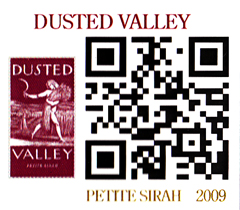
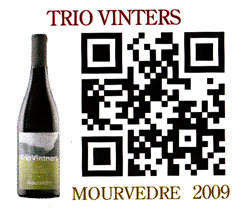

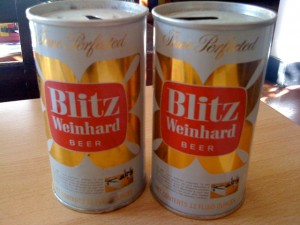
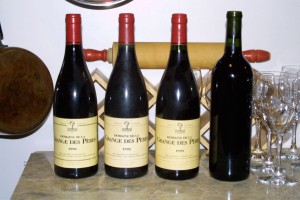
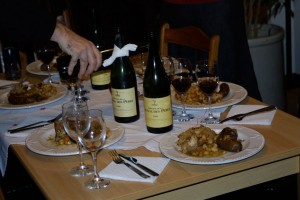
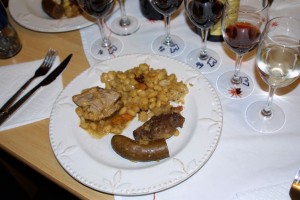

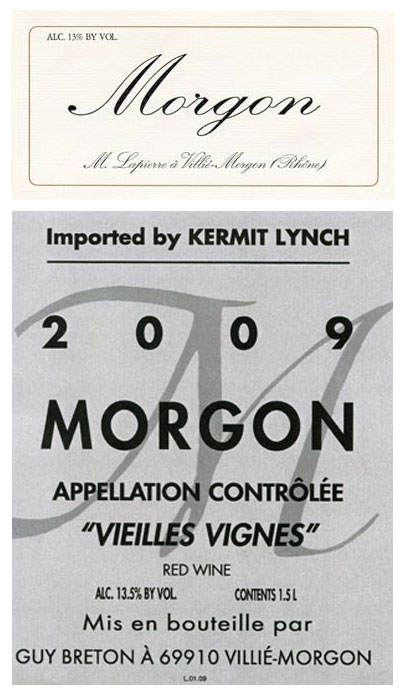 from two paragraphs ago, the grape involved here is also Gamay, so you may be sensing a theme in my favorites, here. It’s been a few years since I’ve had either, but I remember them both as classic, European-styled (naturally) wines. The Guy Breton had more of a spiced, earthy tones while the Lapierre had lighter, fruitier tones with a more bracing acidity. But that’s coming from memory. If you have a hard time recalling the region’s name for when you go to the store to get it, remember: When there isn’t any more, then it’s gone. Get it? More-gone? Ah, never mind.
from two paragraphs ago, the grape involved here is also Gamay, so you may be sensing a theme in my favorites, here. It’s been a few years since I’ve had either, but I remember them both as classic, European-styled (naturally) wines. The Guy Breton had more of a spiced, earthy tones while the Lapierre had lighter, fruitier tones with a more bracing acidity. But that’s coming from memory. If you have a hard time recalling the region’s name for when you go to the store to get it, remember: When there isn’t any more, then it’s gone. Get it? More-gone? Ah, never mind. So let’s face it. We don’t really know jack about Portugal, do we? If you had a similar educational experience like me in the American public school system, we all learned about Portuguese explorer Christopher Columbus, right? Well, it seems his heritage may be disputed and by birth he’s actually Italian. So there goes that little bit of Portuguese history we thought we knew. Okay, but I still remember Vasco de Gama and Ferdinand Magellan. There. Dispute THAT elementary school world history teachers. Other than that, the only thing I’ve learned about Spain’s Iberian neighbor is a bit about their wines.
So let’s face it. We don’t really know jack about Portugal, do we? If you had a similar educational experience like me in the American public school system, we all learned about Portuguese explorer Christopher Columbus, right? Well, it seems his heritage may be disputed and by birth he’s actually Italian. So there goes that little bit of Portuguese history we thought we knew. Okay, but I still remember Vasco de Gama and Ferdinand Magellan. There. Dispute THAT elementary school world history teachers. Other than that, the only thing I’ve learned about Spain’s Iberian neighbor is a bit about their wines.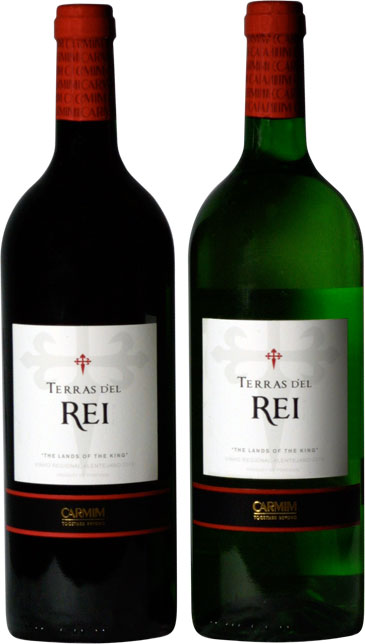 All that said, let’s get to the meat of the matter for the day. Here we have the Carim “Terras D’El Rei”, both red and white. We find them around here for $6.99. And they’re both full 1-Liter bottles, so that stretches the value out a little bit. They hail from the Alentejano region of Portugal. The producer and importer’s websites gave conflicting information from what the bottles themselves stated, and the online photos didn’t match the labels.So I’m going to be relying on the information that is actually on the bottle.
All that said, let’s get to the meat of the matter for the day. Here we have the Carim “Terras D’El Rei”, both red and white. We find them around here for $6.99. And they’re both full 1-Liter bottles, so that stretches the value out a little bit. They hail from the Alentejano region of Portugal. The producer and importer’s websites gave conflicting information from what the bottles themselves stated, and the online photos didn’t match the labels.So I’m going to be relying on the information that is actually on the bottle.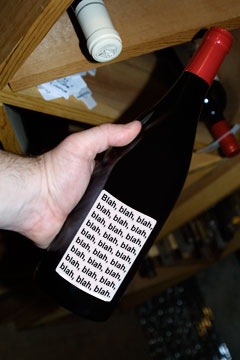



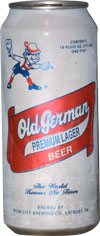 Iron City Old German Premium Lager: This is a fantastic sparkling wine made with a fine blend of barley and hops in the Old German style of winemaking. It even has an Old German guy in lederhosen on the label! You’ll notice I didn’t pay attention to the vintage again because . . . Okay, I’m not fooling anyone. It’s beer. But at some times, for any wine lover on a budget, it comes a time that rather than stoop to the level of the bottom shelf for that jug of engine degreaser passed off as “Burgundy” or “Chablis”, it’s time to get the fizzy yellow stuff we had in college. As every winemaker will tell you, it takes a lot of beer to make good wine.
Iron City Old German Premium Lager: This is a fantastic sparkling wine made with a fine blend of barley and hops in the Old German style of winemaking. It even has an Old German guy in lederhosen on the label! You’ll notice I didn’t pay attention to the vintage again because . . . Okay, I’m not fooling anyone. It’s beer. But at some times, for any wine lover on a budget, it comes a time that rather than stoop to the level of the bottom shelf for that jug of engine degreaser passed off as “Burgundy” or “Chablis”, it’s time to get the fizzy yellow stuff we had in college. As every winemaker will tell you, it takes a lot of beer to make good wine.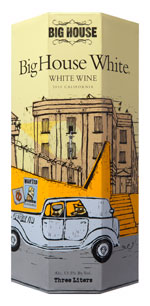 Let’s say single-varietal wines are like solo musicians; you have a pretty good idea what to expect from their performance given the limited aspect of instrumentation. From that idea, then let’s say blends like this are like full bands with multiple members; it gets a lot more complicated and unpredictable. This band has 11 members. Now, not all bands can function with that many players, but say, a well-rehearsed ska band could make that many musicians work as a unit. With that in mind, this wine will probably appeal to a larger audience than your average ska band. I’m not trying to be totally disrespecting the ska bands. I’m just sayin’.
Let’s say single-varietal wines are like solo musicians; you have a pretty good idea what to expect from their performance given the limited aspect of instrumentation. From that idea, then let’s say blends like this are like full bands with multiple members; it gets a lot more complicated and unpredictable. This band has 11 members. Now, not all bands can function with that many players, but say, a well-rehearsed ska band could make that many musicians work as a unit. With that in mind, this wine will probably appeal to a larger audience than your average ska band. I’m not trying to be totally disrespecting the ska bands. I’m just sayin’.